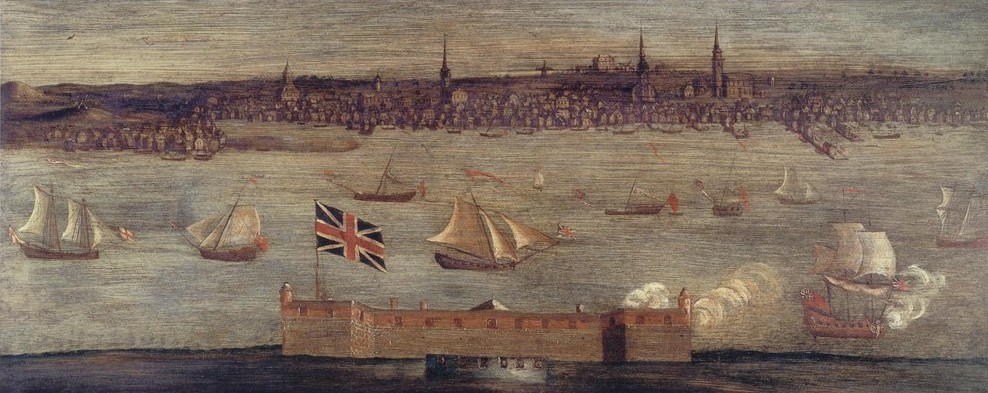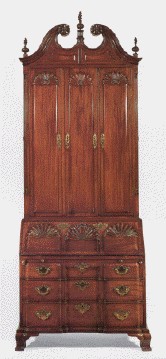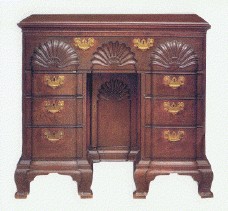
During the eighteenth century,
Newport, Rhode Island was the fifth largest city in the colonies. With
few natural resources available to them on the island, Newporters built an economy on
trade, services, and craft. Along with merchant shipping and rum
distillation, cabinetmaking was one of the major industries.
Both cane sugar for rum and mahogany for furniture were imported directly
from the West Indies.
Over 100 cabinetmakers worked in Newport during the 1700s, producing furniture for local customers and for shipment to the other colonies. Led by the Townsend and Goddard families, Newport cabinetmakers developed furniture designs that were unique among American craftsmen and noted for their exceptional design and workmanship.
Newport furniture designs evolved differently from those of Boston and Philadelphia, with less English influence on the style. Block fronts, curved-ray shells, and bold ball and claw feet were some of the more notable points of Newport furniture, but the forte of Newport makers was their ability to design with striking proportions and use ornament sparingly. As an American art form, rare original examples of Newport furniture are cherished by collectors and museums and command record prices at auction.
The record price for a piece of American furniture is $12.1 million paid in 1988 for the Nicholas Brown secretaire (at right), an unsigned secretaire in the Newport style, which at 113" is the tallest of the nine existing originals. Secretaires with the same details are attributed to Daniel Spencer (1741-1801), a nephew and likely trainee of John Goddard of Newport.
 Another important example of Newport
furniture, and one that testifies to the rarity and importance of an original
finish, is an Edmund Townsend kneehole bureau (left) in virtually
untouched condition that sold in 1995 for $3.6 million, three to four
times the price at that time for a similar piece without a period surface.
Another important example of Newport
furniture, and one that testifies to the rarity and importance of an original
finish, is an Edmund Townsend kneehole bureau (left) in virtually
untouched condition that sold in 1995 for $3.6 million, three to four
times the price at that time for a similar piece without a period surface.
As many as twenty members of the Townsend and
Goddard families were involved (to a greater or lesser extent) in the
cabinetmaking trade in Newport in the 18th and early 19th centuries. The
most prominent members of the families, and those mentioned elsewhere in
this website are as follows:
Christopher (1701-1787) and Job (1699-1765) Townsend were brothers from an Oyster Bay, Long Island family who began the cabinetmaking dynasty in Newport. Each established separate cabinetmaking shops in the Point section of Newport, eventually making a full range of household furniture.
Edmund Townsend (1736-1811) was one of Job's three sons in the business. He trained in his father's shop and later established his own. He is best known for working in the block-front style, and a wealth of block-front bureaus and kneehole bureaus have been authenticated to him. His work is attributable to an identifiable style of shell carving he used throughout his career.
John Goddard (1724-1785) came from a Dartmouth, Massachusetts family and apprenticed in the shop of Job Townsend. He married Job's daughter Hannah and established his own family shop where he trained and made furniture with his sons. The Goddard family shop's work has a sculptural quality and is often identifiable by a unique and realistic carving of ball and claw feet. Three of his sons moved to Nova Scotia after the British occupation of Newport and continued the cabinetmaking trade there. Three younger sons continued the cabinetmaking trade in Newport after their father's death.
John Townsend (1733-1809) trained in his father Christopher's shop and later established his own shop nearby. John Townsend took the Newport style to a high level of development with architectural precision in his case pieces, crisply detailed carving, and tall, stylized ball and claw feet. Like the carving of Edmund Townsend, John Townsend's work is readily identifiable by his style of carving as well as his strict attention to detail.
For more information on Townsend and Goddard cabinetmakers see:
Master Craftsmen of Newport: The Townsends and Goddards, Michael A. Moses and Israel Sack, Inc., Tenafly NJ: MMI Americana Press, 1984.
John Townsend: Newport Cabinetmaker, Morrison H. Heckscher, The Metropolitan Museum of Art, NY: Yale University Press, 2005.
Art & Industry in Early America: Rhode Island Furniture 1650-1830, Patricia E. Kane et al, New Haven CT: Yale University Press, 2016.
RECENT DISCOVERIES AND INVESTIGATIONS:
Signed or Labeled Furniture from the Goddard Family Shop
A Newport Desk Bearing the Inscription S. Goddard
A Desk Signed by Robert Lawton Jr.
Gleanings from Townsend Dovetail Joinery
Identifying Characteristics of Furniture from the Shop of Job Townsend Sr.
The Slater Family Tall-Case Clock
The Discovery and History of a Job E. Townsend Card Table
Yale Demonstration Video: Carving Feet, Shells, Dovetailing
REFERENCE DOCUMENTS:
Will and Inventory of John Goddard (1724-1785)
Children of John and Hannah Goddard
Will and Inventory of Christopher Townsend (1701-1787)
Will and Inventory of John Townsend (1733-1809)